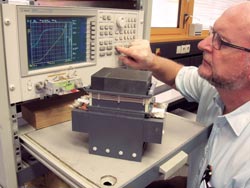Reducing power losses in power supply units

Researchers develop and optimise electricity-saving high frequency litz wires.<br>© Universität Erlangen <br>
High-frequency power supply units are used in almost every electronic device such as television sets, computers and monitors. In conventional devices, three to six per cent of the power supplied is lost in coils and transformers.
The new BINE Projektinfo brochure “Increased efficiency for power supplies” (12/2013) presents optimised high frequency litz wires and windings with a higher degree of efficiency. Given the proliferation of electronic devices among consumers, every small advancement of any single device adds up to significant energy savings.
High frequency litz wires are used in many electronic devices. They consist of many thin, intertwined conductors that are electrically insulated by varnish. Stranded wires suffer the lowest possible power losses when the numerous strands form a large as possible total surface area and care is taken when intertwining that each wire strand occupies every cross-sectional position equally often. The researchers systematically studied the influence of diameter and number of strands, stranding direction and cross-section for different frequency ranges. With this data, high frequency litz wires can be optimised for specific areas of application.
The amount of electricity saved in Germany due to optimised litz wires depends on many factors and can be estimated only roughly. Researchers assume that annual electricity savings in Germany would amount to 5o million kWh. This is equivalent to the electricity demand of 12,500 four-person households. The research project was conducted by the Friedrich-Alexander-Universität Erlangen-Nürnberg in cooperation with industry partners.
The BINE Projektinfo brochure, which can be obtained free of charge from the BINE Information Service at FIZ Karlsruhe, is available online at www.bine.info or by calling +49 (0)228 92379-0.
Press contact
Uwe Milles
presse(at)bine.info
About BINE Information Service
Energy research for practical applications
The BINE Information Service reports on energy research topics, such as new materials, systems and components, as well as innovative concepts and methods. The knowledge gained is incorporated into the implementation of new technologies in practice, because first-rate information provides a basis for pioneering decisions, whether in the planning of energy-optimised buildings, increasing the efficiency of industrial processes, or integrating renewable energy sources into existing systems.
About FIZ Karlsruhe
FIZ Karlsruhe – Leibniz Institute for Information Infrastructure is a not-for-profit organization with the public mission to make sci-tech information from all over the world publicly available and to provide related services in order to support the national and international transfer of knowledge and the promotion of innovation.
Our business areas:
• STN International – the world’s leading online service for research and patent information in science and technology
• KnowEsis – innovative eScience solutions to support the process of research in all its stages, and throughout all scientific disciplines
• Databases and Information Services – Databases and science portals in mathematics, computer science, crystallography, chemistry, and energy technology
FIZ Karlsruhe is a member of the Leibniz Association (WGL) which consists of 87 German research and infrastructure institutions.
Media Contact
More Information:
http://www.bine.info/enAll latest news from the category: Power and Electrical Engineering
This topic covers issues related to energy generation, conversion, transportation and consumption and how the industry is addressing the challenge of energy efficiency in general.
innovations-report provides in-depth and informative reports and articles on subjects ranging from wind energy, fuel cell technology, solar energy, geothermal energy, petroleum, gas, nuclear engineering, alternative energy and energy efficiency to fusion, hydrogen and superconductor technologies.
Newest articles

Combatting disruptive ‘noise’ in quantum communication
In a significant milestone for quantum communication technology, an experiment has demonstrated how networks can be leveraged to combat disruptive ‘noise’ in quantum communications. The international effort led by researchers…

Stretchable quantum dot display
Intrinsically stretchable quantum dot-based light-emitting diodes achieved record-breaking performance. A team of South Korean scientists led by Professor KIM Dae-Hyeong of the Center for Nanoparticle Research within the Institute for…

Internet can achieve quantum speed with light saved as sound
Researchers at the University of Copenhagen’s Niels Bohr Institute have developed a new way to create quantum memory: A small drum can store data sent with light in its sonic…





















